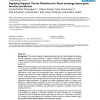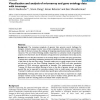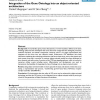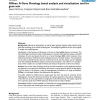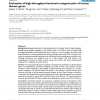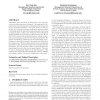BMCBI
2004
14 years 2 months ago
2004
Background: The current progress in sequencing projects calls for rapid, reliable and accurate function assignments of gene products. A variety of methods has been designed to ann...
BMCBI
2004
14 years 2 months ago
2004
Background: The increasing complexity of genomic data presents several challenges for biologists. Limited computer monitor views of data complexity and the dynamic nature of data ...
BMCBI
2005
14 years 2 months ago
2005
Background: Biological processes are carried out by coordinated modules of interacting molecules. As clustering methods demonstrate that genes with similar expression display incr...
BMCBI
2005
14 years 2 months ago
2005
Background: Structural and functional research often requires the computation of sets of protein structures based on certain properties of the proteins, such as sequence features,...
BMCBI
2005
14 years 2 months ago
2005
Background: To standardize gene product descriptions, a formal vocabulary defined as the Gene Ontology (GO) has been developed. GO terms have been categorized into biological proc...
BMCBI
2005
14 years 2 months ago
2005
Background: Microarray experiments, as well as other genomic analyses, often result in large gene sets containing up to several hundred genes. The biological significance of such ...
NAR
2008
14 years 2 months ago
2008
The Gene Ontology (GO) project (http://www.gene ontology.org/) provides a set of structured, controlled vocabularies for community use in annotating genes, gene products and seque...
BMCBI
2007
14 years 2 months ago
2007
Background: Biological data that are well-organized by an ontology, such as Gene Ontology, enables high-throughput availability of the semantic web. It can also be used to facilit...
BMCBI
2007
14 years 2 months ago
2007
Annotating genes and their products with Gene Ontology codes is an important area of research. One approach for doing this is to use the information available about these genes in...
BMCBI
2007
14 years 2 months ago
2007
Background: The search for enriched features has become widely used to characterize a set of genes or proteins. A key aspect of this technique is its ability to identify correlati...
